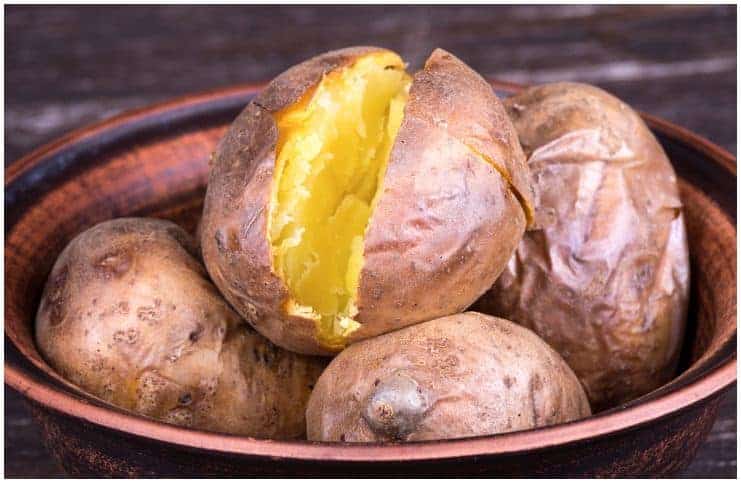Cauliflower
It belongs to the group of vegetables called brassica or cruciferous vegetables that also includes Brussels sprouts, broccoli, kale, cabbage, turnips, and rutabaga.
This cruciferous vegetable can be consumed in cooked, raw, or pickled form, however, its raw form holds the highest nutritional value.
Nutrition Facts
It is a good source of vitamin C, thiamin, folate, potassium, vitamin K, calcium, phosphorus, dietary fiber, protein, pantothenic acid, magnesium, manganese, copper, iron, zinc, selenium, molybdenum, and boron.
Health Benefits
Reduces The Risk Of Breast Cancer
Cruciferous vegetables (including this one) contain Indole-3-Carbinol, a phytonutrient that is derived from the breakdown of glucobrassicin, a compound found in almost all cruciferous vegetables.
According to numerous studies, Indole-3-Carbinol impede estrogen receptors in breast membranes, reducing considerably the risk of breast cancer. Moreover, it has been shown to cause programmed cell death (a process also called apoptosis) in acute myeloid leukemia cells.
The sulforaphane content in this vegetable has been shown to be efficient at blocking the growth of tumors and killing cancer-causing cells.
Rheumatoid Arthritis Prevention
This vegetable is a remarkable source of vitamin B5, also called pantothenic acid, a nutrient that supports healthy brain function and helps to regulate the natural hormone balance.
This B complex vitamin also has an essential role in transforming carbohydrates into energy needed by the human body for day-to-day activities. In addition, according to research, people with rheumatoid arthritis have lower levels of vitamin B5 in their blood than healthy people, plus, the lowest levels were linked with the most severe symptoms.
Bone Health
The presence of boron in this popular vegetable makes absorption of magnesium and calcium more efficiently. This is goods news for sufferers of osteoporosis. Also, some studies have concluded that boron has an important role in brain function.
Side Effects
Some people may experience adverse reactions to eating this cruciferous vegetable (especially when consumed raw) with symptoms including – hand and facial swelling, severe itching, and breathing difficulties.
In addition, overconsumption may disrupt the body’s capacity to absorb iodine, which can lead to thyroid problems.
Potato
It is an edible stem vegetable that belongs to the perennial nightshade “Solanum tuberosum,“ a family of plants that also includes peppers, tobacco, aubergines, tomatoes, and chilies.
Nutrition Facts
It is an excellent source of selenium, manganese, iron, potassium, folate, vitamin C, pantothenic acid, magnesium, phosphorus, vitamin B6, niacin, riboflavin, dietary fiber, protein, and vitamin K.
Health Benefits
Feeds The Good Gut Bacteria
This vegetable is not the best source of dietary fiber, however, when cooled down after boiling, it contains resistant starch, a type of fiber that you can’t digest, but the healthy gut flora can.
When the bacteria in the large intestine gobble up resistant starch, they make butyrate, a short-chain fatty acid that is fuel for the cells which line the large intestine.
Skin Health
100g of this tuber has about 9,6 mg of vitamin C, which is about 16 percent of the daily recommended intake, a nutrient which aids in efficient iron absorption, supports a healthy immune system, aids in wound healing, and produces collagen – a protein which helps keep the skin healthy.
Deficiency of vitamin C leads to the fragility of blood vessels, dry red spots on the skin, disruption of connective tissue, and gingivitis (inflammation of the gums).
Cardiovascular Health
According to studies, the skin of this tuber is high in potassium, an essential mineral that can help lower blood pressure. Also, a regular diet low in potassium can considerably increase “vascular calcification,” a serious condition also known as hardening of the arteries, and represents an increased risk of arrhythmia (a problem with the rate of the heartbeat).
Lowers Your Stress Levels
100g of this tuber has 0,3 mcg of vitamin B6 (part of the vitamin B complex family) which is approximately 16% of the daily recommended intake.
Vitamin B6 helps the human body to produce the hormones norepinephrine (helps the body cope with stress) and serotonin (regulates mood).
A deficiency of vitamin B6 may lead to dry skin, a loss of appetite, the appearance of cracks around the lips, hair loss, swelling of the mouth, and insomnia.
Side Effects
There are no scientifically proven side effects, except when you consume them fried.
Cauliflower vs Potato – Which Has A Better Nutritional Profile?
Both these vegetables have a similar nutritional profile and should be part of your regular diet (with the exception of french fries), but the balance is a little inclined in the favor of cauliflower due to its increased level of vitamin C, vitamin K, and folate.
Featured image credit – Shutterstock
READ THIS NEXT: Broccoli vs Cauliflower
